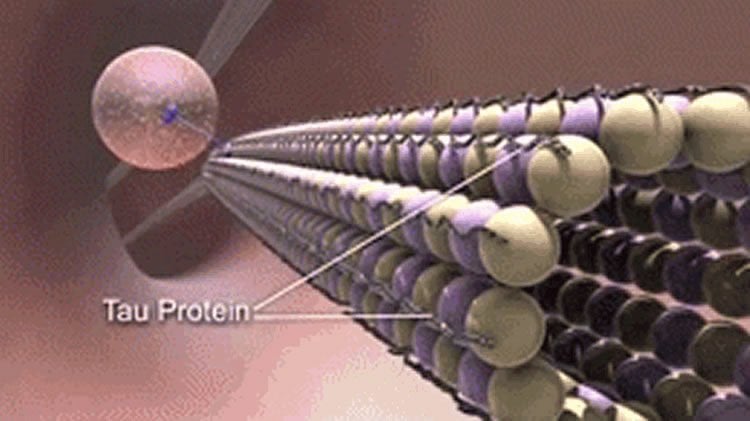Summary: Study reveals Tau proteins disrupt synaptic transmission in early stages of neurodegenerative diseases.
Source: VIB Flanders.
Tau proteins are involved in more than twenty neurodegenerative diseases, including various forms of dementia. These proteins clump together in patients’ brains to form neuronal tangles: protein aggregation that eventually coincides with the death of brain cells. Prof. Patrik Verstreken’s research team (VIB-KU Leuven) has now discovered how tau disrupts the functioning of nerve cells, even before it starts forming tangles. They immediately suggest a way to intervene in this process.
Tau proteins are best known as the proteins that are stacked to form neuronal “tangles” in Alzheimer’s patients’ brains, but they also play a role in many other brain disorders such as Parkinson’s and Huntington’s disease. In healthy circumstances, tau proteins are connected to the cytoskeleton of nerve cells, where they support the cells’ structural stability. In the nerve cells of patients, however, tau is dislodged from the cytoskeleton and ultimately tangles together to form protein accumulations that disrupt the nerve cell’s functioning.
Early spoilsport
But even before these protein accumulations are formed, the dislodged tau impedes the communication between nerve cells. VIB’s research team has described a new mechanism for this in the journal Nature Communications.
Professor Patrik Verstreken (VIB-KU Leuven) explains: “We have demonstrated that when mutant tau dislodges from the cytoskeleton, it mainly settles at the synapses of the nerve cells. This was not only the case in fruit flies and rats but also in the brain cells of human patients. Vesicles containing chemicals are released at these synapses, which serve as the means of communication between two different nerve cells. When tau settles at the synapse, it locks onto the vesicles, inhibiting synaptic transmission.”
Fundamental research with prospects for therapeutic applications
These new insights are the result of a close collaboration between different laboratories at VIB, the universities of Leuven, Louvain-la-Neuve (both in Belgium), and Edinburgh (UK), and with researchers from Janssen Pharmaceutica. They pave the way for a possible treatment.

“Now that we know how tau inhibits synaptic transmission, we can look for ways to prevent it.” Patrik Verstreken already provided proof of principle: “If we stop tau from locking onto the vesicles in the nerve cells of rats and fruit flies, we can prevent the inhibition of synaptic transmission and also the death of nerve cells.” Further research should reveal whether this strategy will also be useful for patients.
Source: Sooike Stoops – VIB Flanders
Image Source: NeuroscienceNews.com image is in the public domain.
Original Research: Full open access research for “Tau association with synaptic vesicles causes presynaptic dysfunction” by Lujia Zhou, Joseph McInnes, Keimpe Wierda, Matthew Holt, Abigail G. Herrmann, Rosemary J. Jackson, Yu-Chun Wang, Jef Swerts, Jelle Beyens, Katarzyna Miskiewicz, Sven Vilain, Ilse Dewachter, Diederik Moechars, Bart De Strooper, Tara L. Spires-Jones, Joris De Wit & Patrik Verstreken in Nature Communications. Published online May 11 2017 doi:10.1038/ncomms15295
[cbtabs][cbtab title=”MLA”]VIB Flanders “Tau Prevents Synaptic Transmission at Early Stage of Neurodegeneration.” NeuroscienceNews. NeuroscienceNews, 19 May 2017.
<https://neurosciencenews.com/tau-neurodegeneration-synaptic-transmission-6727/>.[/cbtab][cbtab title=”APA”]VIB Flanders (2017, May 19). Tau Prevents Synaptic Transmission at Early Stage of Neurodegeneration. NeuroscienceNew. Retrieved May 19, 2017 from https://neurosciencenews.com/tau-neurodegeneration-synaptic-transmission-6727/[/cbtab][cbtab title=”Chicago”]VIB Flanders “Tau Prevents Synaptic Transmission at Early Stage of Neurodegeneration.” https://neurosciencenews.com/tau-neurodegeneration-synaptic-transmission-6727/ (accessed May 19, 2017).[/cbtab][/cbtabs]
Abstract
Tau association with synaptic vesicles causes presynaptic dysfunction
Tau is implicated in more than 20 neurodegenerative diseases, including Alzheimer’s disease. Under pathological conditions, Tau dissociates from axonal microtubules and missorts to pre- and postsynaptic terminals. Patients suffer from early synaptic dysfunction prior to Tau aggregate formation, but the underlying mechanism is unclear. Here we show that pathogenic Tau binds to synaptic vesicles via its N-terminal domain and interferes with presynaptic functions, including synaptic vesicle mobility and release rate, lowering neurotransmission in fly and rat neurons. Pathological Tau mutants lacking the vesicle binding domain still localize to the presynaptic compartment but do not impair synaptic function in fly neurons. Moreover, an exogenously applied membrane-permeable peptide that competes for Tau-vesicle binding suppresses Tau-induced synaptic toxicity in rat neurons. Our work uncovers a presynaptic role of Tau that may be part of the early pathology in various Tauopathies and could be exploited therapeutically.
“Tau association with synaptic vesicles causes presynaptic dysfunction” by Lujia Zhou, Joseph McInnes, Keimpe Wierda, Matthew Holt, Abigail G. Herrmann, Rosemary J. Jackson, Yu-Chun Wang, Jef Swerts, Jelle Beyens, Katarzyna Miskiewicz, Sven Vilain, Ilse Dewachter, Diederik Moechars, Bart De Strooper, Tara L. Spires-Jones, Joris De Wit & Patrik Verstreken in Nature Communications. Published online May 11 2017 doi:10.1038/ncomms15295






